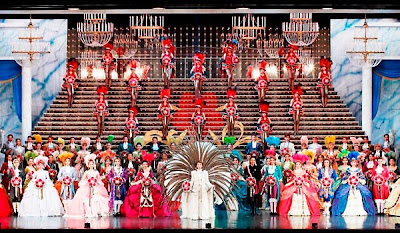Noh - Japanese Theater III
 |
| Yamanba, "mountain hag", costume. Photo from here. |
Noh is probably the most abstract form of traditional Japanese theater. It's very slow-paced and subtle, and to Western audiences would most likely seem the most foreign. It originated in the 14th century with performances of folk stories often featuring deities or supernatural creatures.
Noh is usually performed by one actor playing the protagonist, called shite, and one actor playing the foil, called waki. Sometimes the shite has a companion, or there may be other minor characters. The performance is narrated by a chorus of chanters, who are accompanied by musicians. There are four instruments used in Noh: a flute, shoulder-drum, hip-drum and taiko drum. Originally a performance would involve 5 Noh plays with short, usually comedic Kyogen interludes. Nowadays, there are only 2 Noh plays with a Kyogen play set in between.
Most Noh actors wear masks. These masks are generally carved from wood, but some are made from other materials like clay or fabric. The masks are a good example of the subtlety of Noh acting- they appear to have only one expression, but when the actor tilts the mask very slightly in a specific way, the fall of light and shadow can create a wide variety of emotions.
 |
| The same mask, tilted to create different expressions. Pretty much creepy at any angle, though. |
Kami-mono, or plays about deities, in which the shite usually reveals themselves to be a deity halfway through the play.
Shura-mono, or plays about the ghosts of fallen warriors. Usually the shite first appears as a ghost, then in the second half of the play reenacts their death.
Onna-mono, or plays featuring a female protagonist.
Oni-mono, or plays in which the shite is a monster, demon, goblin, etc.
 |
| A woman-turned-oni mask. Further proof that Noh is pretty freaky. |
Noh plays generally come from folk lore, especially legends about deities and supernatural beings. However, some plays are also adapted from famous works of literature, such as The Tale of Genji or The Tale of the Heike. Shura-mono especially tend to be drawn from those sources.
One of the founders of Noh and one of its most famous writers and actors, is Zeami Motokiyo. In addition to writing a number of famous plays, he also wrote a series of essays describing how Noh should be performed. Noh is probably the least flexible of all Japanese theater; it's extremely traditional and innovation by the actors tends to be frowned upon.
When traveling around Japan, it's possible to see Noh stages located near famous temples. The oldest and one of the most beautiful is located on Miyajima island, near Hiroshima. It's part of the Floating Pavilion, a series of temples and walkways built over the ocean. During high tide, the Noh stage along with the other buildings appear to float on the water.
 |
| The oldest Noh stage, in Miyajima. |
Other posts on Japanese Theater:


I didn't know about this kind of think at all, very interesting. I would like to see a play completely surrounded with water. I bet it gives a sort of ambiance to the performance.
ReplyDeleteI know! Noh is already really eerie, with the masks and the weird chanting, plus most of the stories are about monsters/ghosts/gods/etc... I would kill to see that performed on a floating stage at night.
ReplyDelete